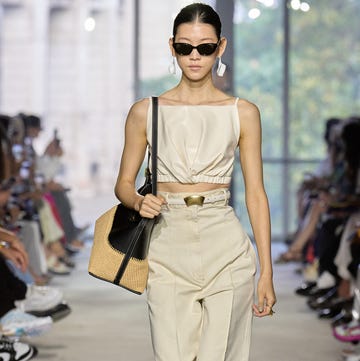Earlier this Fashion Week, Hillary Taymour of Collina Strada told everyone to “touch grass.” Backstage at her show on Sunday, a similarly offline sentiment was coming from designer Sandy Liang, who recently collaborated with Android on a FlipSuit phone case and a set of hairpins. Guests at the show, held at the Altman Building in Lower Manhattan, found the hair accessories waiting on their seats, which were arranged around a runway covered in a fluffy pink rug.
When I ask Liang what she loved about working on a flip phone project, she says, “I love that it is so small and compact and fits everywhere. It’s the whole world in your hands.” Her world of bows and ballet flats is steeped in nostalgia and a sense of chasing the feeling of a youth you’ll never have again. Liang is so good at it that it’s easy to imagine she actually lives there—but she’s actually stuck in 2024, like the rest of us. “I miss that world where your phone was just where you had calls,” she says. “It wasn’t everything.”
Flip phones represent a simpler time, sans social media and doomscrolling and having everyone you’ve ever wanted in the palm of your hand. Liang’s collection also felt notably pared back, replacing Y2K exuberance with ’90s minimalism. Models wore simple jersey dresses, plaid two-piece sets, long button-down tunics with matching pleated bandannas. There weren’t as many ribbons as there have been in the past. It very much felt like a collection you’d save as the background of your flip phone, instead of posting it on your Instagram Story.
Liang tells me that her girl is a New Yorker for whom nothing is “too precious”—she wears what she wants on the subway. Ib Kamara’s Off-White also presented a vision of a real New Yorker. The label’s show normally takes place in Paris, but came to the city this week for a show at Brooklyn Bridge Park on Sunday. Kamara titled it “Duty Free” and mentioned in the show notes that he’d been inspired by a trip he took to Ghana. “I have vivid memories of what America, and New York in particular, represented in the collective imagination of Africans: a dreamland of utopias made real, a place of opportunities,” he wrote. “The lotteries in which the main prize would be a possibility to enter the States were major events for us.”
There’s a fierce utilitarian feel to the Off-White collection, with strategically placed zippers on tops and pants, meant to allow for the multipurpose nature of a New Yorker, who could be doing anything on any given day. The womenswear was also particularly sexy, with fabric that sculpted and fell off the body. If Sandy Liang’s girl isn’t too precious, then Kamara’s New Yorker is downright fearless.
At Bach Mai the same day, at Chelsea Factory, Mai wasn’t afraid to be vulnerable in his show notes either, writing about the darkness that engulfed him after the death of his father last year: “This darkness extended to all aspects of my life, in particular my creative universe. It was in the depths of this winter that I was reminded of my father’s reaction to my debut collection, ‘Where is all the color?’ ”
The Spring 2025 collection answered that question with bright reds and oranges and pinks, inspired by the art of James Turrell and the architecture of Luis Barragán. Mai was also inspired by an iconic photo of Charles James’s gowns by Cecil Beaton, and used it as a jumping-off point to reenvision his own idea of American glamour. What that looks like in a Bach Mai world: pants made of organza and long, sheer boatneck tops with trains.
And as expected, Eckhaus Latta too had its own notions of American glamour and about what a fashion show should be like. This season, guests were instructed to wear the brand for dinner Sunday night in a TriBeCa loft. Those who were wearing the latest collection were asked to do an impromptu runway walk in the space between the tables, as audience members rose from their chairs to cheer. The pieces felt familiar from afar—cardigans, knit tops, denim jackets—but when approached, it was clear that each one was designed with elements to set it apart, which has always been the Eckhaus Latta way.

















